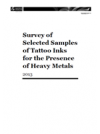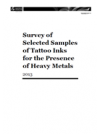The Ministry of Health surveyed tattoo inks to assess whether the tattoo inks supplied by established (mainstream) manufacturers or suppliers of tattoo ink supplies complied with the maximum concentrations of heavy metals recommended by the Environmental Protection Authority's Guidelines for Tattoo and Permanent Make-up Substances. There were 169 inks tested, from 18 different brands, and covering 118 colour-variants. Inks were selected from a range of established brands that were commercially available (in most cases, directly from the manufacturer’s or suppliers’ website). Some brands also had New Zealand-based suppliers. The tattoo inks were analysed for arsenic, barium, cadmium, cobalt, chromium (VI), copper soluble, mercury, nickel, lead, selenium, antimony, tin and zinc. These chemicals are heavy metals listed in the Environmental Protection Authority's Guidelines and were tested because they are known to be of public health significance, and testing is readily available. The survey did not test for other compounds that may be present in, or added to, the inks. The colour samples analysed were generally compliant with the maximum permissible levels of heavy metals specified in the Guidelines. All samples tested complied with cobalt, selenium and chromium (VI) guideline levels. For the other metals there was variable compliance.
Purpose
The aim of the survey is to assess whether the tattoo inks supplied by identified, easily accessible, common or commercially established brands of tattoo ink suppliers (listed in Appendix 1) comply with maximum concentrations of heavy metals in the EPA’s guidelines.
Methodology
Method
Sample selection
A sample of 169 inks was purchased from 10 manufacturers’ or larger international suppliers’ websites (listed in Appendix 1). There were 18 brands sampled which consisted of 118 colour-variants. For all brands, one sample was purchased for each colour-variant and analysed except for the following brands: Tattoo Colour King (2 samples for each colour-variant); Silverback ink (grey wash series (4), silver back white (2); and grey wash series fresh (2); Mom’s Millennium Colourworks (piss yellow (3), blue balls (2)); Intenze (bright red (2), lemon yellow (2), true black (2)). Brands and colour-variants are listed in Appendix 2. Inks were selected from across a range of established brands that are commercially available on the market (usually via the internet direct from the manufacturer’s or suppliers’ websites). Some brands also have New Zealand-based suppliers.
In selecting the brands of tattoo ink for analysis, and the colour-variants to be tested within each brand, the Ministry sought input from the newly formed New Zealand Tattoo Association. The Association comprises a small group of Auckland tattooists. The Association does not hold itself up as representing the views of New Zealand tattooists or the wider tattoo industry.
The survey is intended to provide a snapshot of some easily available, common or commercially established brands of tattoo inks sourced from suppliers named in this survey and therefore, the survey has a very limited scope
Information was collected on the location of the suppliers’ website, along with the cost, product brand, batch number and colour-variant of the product that was sampled.
The Ministry did not advise the suppliers it was purchasing the inks or the purpose for which the inks were being purchased (ie, to be tested for their heavy metal concentrations).
Scope and limitations
The focus of the survey was restricted to analysing the selected tattoo inks for the 13 heavy metals listed in the Guidelines – the survey did not test for other compounds that may be present in or added to the inks.
The survey did not look at how the inks are manufactured or any tattooing practices or procedures. In addition:
- it was not feasible to sample all brands of tattoo inks, nor all of the colour-variants of inks, on the market in New Zealand
- only pre-made inks sold in liquid form were tested (ie, no pigments that need to be mixed with another substance were tested)
- inks were predominantly sourced directly from overseas manufacturers or suppliers and not from New Zealand intermediaries
- inks manufactured or mixed within New Zealand were not tested
- substances that may be used for tattooing but are not sold as tattoo inks (eg, printer inks) were not tested
- the survey only assessed compliance with the guidelines and did not assess health risk.
Analysis of tattoo inks
Samples were analysed for arsenic, barium, cadmium, cobalt, chromium (VI), copper soluble, mercury, nickel, lead, selenium, antimony, tin and zinc by the Eurofins Environmental Laboratory Services (ELS). The bulk of heavy metals were analysed by microwave digestion in acid, followed by dilution and multi-element analysis on Inductively Coupled Plasma-Mass Spectroscopy (ICP-MS). Buffered (pH5.5) aqueous extraction, dilution and ICP-MS analysis were employed in determining the soluble copper concentration. The Institute of Environmental Science and Research Ltd (ESR) analysed chromium (VI) using a modified version of the US EPA Method 218.7 by ion chromatography with post-column derivatisation and UV-visible spectroscopic detection.


